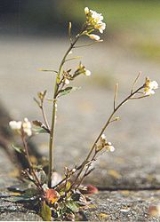
Arabidopsis thaliana
Overview
Flowering plant
The flowering plants , also known as Angiospermae or Magnoliophyta, are the most diverse group of land plants. Angiosperms are seed-producing plants like the gymnosperms and can be distinguished from the gymnosperms by a series of synapomorphies...
native to Europe
Europe
Europe is, by convention, one of the world's seven continents. Comprising the westernmost peninsula of Eurasia, Europe is generally 'divided' from Asia to its east by the watershed divides of the Ural and Caucasus Mountains, the Ural River, the Caspian and Black Seas, and the waterways connecting...
, Asia
Asia
Asia is the world's largest and most populous continent, located primarily in the eastern and northern hemispheres. It covers 8.7% of the Earth's total surface area and with approximately 3.879 billion people, it hosts 60% of the world's current human population...
, and northwestern Africa
Africa
Africa is the world's second largest and second most populous continent, after Asia. At about 30.2 million km² including adjacent islands, it covers 6% of the Earth's total surface area and 20.4% of the total land area...
. A spring annual
Annual plant
An annual plant is a plant that usually germinates, flowers, and dies in a year or season. True annuals will only live longer than a year if they are prevented from setting seed...
with a relatively short life cycle, arabidopsis is popular as a model organism
Model organism
A model organism is a non-human species that is extensively studied to understand particular biological phenomena, with the expectation that discoveries made in the organism model will provide insight into the workings of other organisms. Model organisms are in vivo models and are widely used to...
in plant biology and genetics. Arabidopsis thaliana has a rather small genome
Genome
In modern molecular biology and genetics, the genome is the entirety of an organism's hereditary information. It is encoded either in DNA or, for many types of virus, in RNA. The genome includes both the genes and the non-coding sequences of the DNA/RNA....
, only 157 megabase pairs
Base pair
In molecular biology and genetics, the linking between two nitrogenous bases on opposite complementary DNA or certain types of RNA strands that are connected via hydrogen bonds is called a base pair...
(Mbp), and was thought for a long time to have the smallest genome of all flowering plants, but the smallest flowering plants' genomes now known belong to plants in the genus Genlisea
Genlisea
Genlisea is a genus of carnivorous plants also known as corkscrew plants. The 21 species grow in wet terrestrial to semi-aquatic environments distributed throughout Africa and Central and South America. The plants use highly modified underground leaves to attract, trap and digest minute...
, order Lamiales
Lamiales
Lamiales is an order in the asterid group of dicotyledonous flowering plants. It includes approximately 11,000 species divided into about 20 families...
, with Genlisea margaretae
Genlisea margaretae
Genlisea margaretae is a carnivorous species in the genus Genlisea native to areas of Madagascar, Tanzania, and Zambia. It has pale bundles of root-like organs up to about 20 cm long under ground that attract, trap, and digest protozoans. These organs are subterranean leaves, which lack chlorophyll...
, a carnivorous plant, showing a genome size of 63.4 Mbp.
Unanswered Questions

